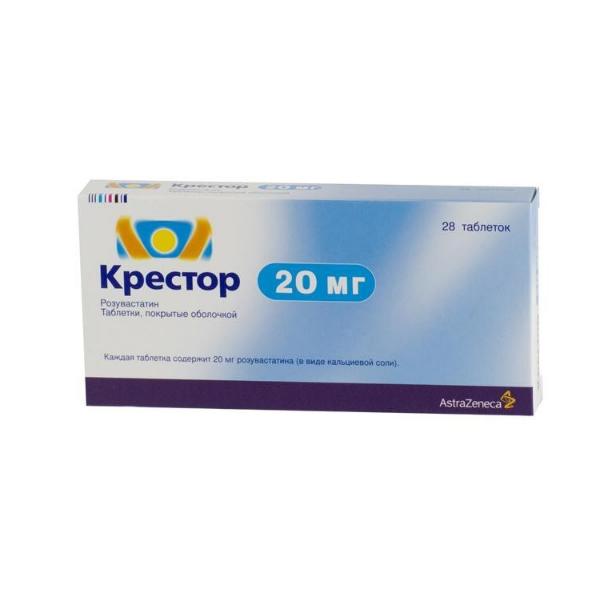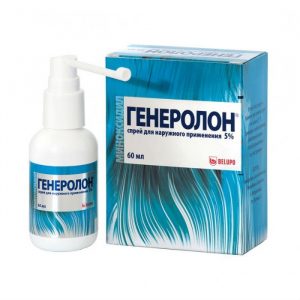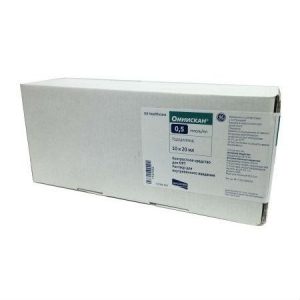Description
Packing
28 pcs
Pharmacological action
Selective competitive inhibitor of HMG-CoA reductase, an enzyme that converts 3-hydroxy-3-methylglutaryl coenzyme A to mevalonate, a precursor of cholesterol (Xc).
Rosuvastatin increases the number of hepatic LDL receptors on the cell surface, increasing the uptake and catabolism of LDL, which, in turn, leads to inhibition of the synthesis of VLDL, thereby reducing the total amount of LDL and VLDL.
Krestor reduces elevated levels of LDL-C, total cholesterol, triglycerides (TG), increases HDL-C, and also lowers apolipoprotein B (ApoV), non-HDL-C, HDL-V, TG-VLDL and increases apolipoprotein 1 (ApoA-1), reduces the ratio of Xs-LDL / Xs-HDL, total Xs / Xs-HDL and Xs-non-HDL / Xs-HDL, and the ratio of ApoV / ApoA-1.
The therapeutic effect appears within 1 week. after the start of therapy and after 2 weeks of treatment is 90% of the maximum possible effect, which is usually achieved by 4 weeks and after that remains constant.
Crestor is effective in adult patients with hypercholesterolemia with or without hypertriglyceridemia (regardless of race, gender or age), including in patients with diabetes mellitus and with familial hypercholesterolemia.
In 80% of patients with type IIa and type IIb hypercholesterolemia (average baseline LDL-C level of about 4.8 mmol / l) when taking the drug at a dose of 10 mg, LDL-C level reaches values. In patients with heterozygous familial hypercholesterolemia when using Crestor at a dose of 20 -80 mg showed a positive dynamics in the lipid profile (study involving 435 patients). After titration to a daily dose of 40 mg (12 weeks of therapy), there is a decrease in the level of LDL-C by 53%. In 33% of patients, the level of LDL-C is achieved in patients with homozygous familial hypercholesterolemia with the use of Krestor at a dose of 20 mg and 40 mg, the average decrease in the level of LDL-C is 22%.
The additive effect is observed in combination with fenofibrate in relation to the content of TG and with nicotinic acid in relation to the content of HDL-C.
Studies on the effect of rosuvastatin on reducing the number of complications caused by lipid disorders (such as coronary heart disease) are not yet complete.
Indications
Hypercholesterolemia (type IIa, including familial heterozygous hypercholesterolemia) or mixed hypercholesterolemia (type IIb) as a supplement to diet, when diet and other non-pharmacological treatments (for example, exercise, weight loss and hypertensive hypertrophy) as a supplement to diet and other cholesterol lowering therapy, or in cases where such therapy is not suitable for the patient.
Contraindications
hypersensitivity to rosuvastatin or any of the components of the drug
liver disease in the active phase, including a persistent increase in serum transaminase activity and any increase in serum transaminase activity (more than 3 times compared with VGN)
pronounced renal dysfunction (Cl creatinine less than 30 ml / min)
myopathy
concomitant use of cyclosporine
in women: pregnancy, lactation, lack of adequate methods of contraception
patients, pre lactose intolerance, lactase deficiency or glucose-galactose malabsorption (the drug contains lactose) is prone to the development of myotoxic complications of
.
Use during pregnancy and lactation
The cross is contraindicated in pregnancy and lactation. If pregnancy occurs during therapy, the drug should be stopped immediately.
Women of reproductive age should use adequate methods of contraception. Since cholesterol and its biosynthesis products are important for fetal development, the potential risk of inhibiting HMG-CoA reductase exceeds the benefit of using the drug.
Clinical data on the allocation of rosuvastatin with breast milk are not available, so if you need to use Krestor during lactation, breastfeeding should be stopped.
Experimental studies have found that rosuvastatin is excreted in rat milk.
Composition
1 tablet contains:
Active ingredient:
rosuvastatin (in the form of calcium salt) 20 mg
Excipients:
lactose monohydrate
MCC
calcium phosphate
c crd.
Dosage and administration
Inside, without chewing or grinding the tablet, swallowed whole, washed down with water. The drug can be prescribed at any time of the day, regardless of food intake.
Before starting Krestor therapy, the patient should start following a standard hypocholesterolemic diet and continue following it during treatment. The dose of the drug should be selected individually, depending on the goals of therapy and the therapeutic response to treatment, taking into account current recommendations on the target concentration of lipids.
The recommended starting dose for patients starting to take the drug, or for patients transferred from other HMG-CoA reductase inhibitors, should be 5 or 10 mg of Crestor once a day. When choosing an initial dose, you should be guided by an individual concentration of cholesterol and take into account the possible risk of cardiovascular complications, and it is also necessary to assess the potential risk of side effects. If necessary, the dose can be increased to a larger after 4 weeks.
Due to the possible development of side effects when taking a dose of 40 mg, compared with lower doses of the drug, increasing the dose to 40 mg, after an additional dose is higher than the recommended initial dose for 4 weeks of therapy, can be carried out only in patients with a severe degree hypercholesterolemia and with a high risk of cardiovascular complications (especially in patients with familial hypercholesterolemia) who have not achieved the desired result of therapy when taking a dose of 20 mg, and which will be under the supervision of a specialist. Particularly careful monitoring of patients receiving the drug at a dose of 40 mg is recommended.
Dosage of 40 mg is not recommended for patients who have not previously consulted a doctor. After 2 4 weeks of therapy and / or with an increase in the dose of Krestor ®, monitoring of lipid metabolism is necessary (dose adjustment is necessary if necessary).
Elderly patients. No dose adjustment required.
Patients with renal failure. In patients with mild or moderate renal failure, dose adjustment is not required. In patients with severe renal failure (Clcreatinin less than 30 ml / min), the use of the drug Krestor ® is contraindicated. The use of the drug at a dose of 40 mg is contraindicated in patients with moderate impaired renal function (creatinine Cl 30-60 ml / min). For patients with moderate impaired renal function, an initial dose of 5 mg is recommended.
Patients with liver failure. Krestor ® is contraindicated in patients with active liver disease.
Special populations
Ethnic groups. When studying the pharmacokinetic parameters of rosuvastatin in patients belonging to different ethnic groups, an increase in the systemic concentration of rosuvastatin in Japanese and Chinese was noted. This fact should be taken into account when prescribing Crestor ® to these patient groups. When prescribing doses of 10 and 20 mg, the recommended initial dose for patients of the Mongoloid race is 5 mg. Administration of the drug in a dose of 40 mg is contraindicated for patients of the Mongoloid race.
Patients predisposed to myopathy. The use of the drug in a dose of 40 mg is contraindicated in patients with factors which may indicate a predisposition to the development of myopathy. When prescribing doses of 10 and 20 mg, the recommended initial dose for this group of patients is 5 mg.
Side effects
Immune system: rarely – hypersensitivity reactions, including angioedema.
Endocrine system: often type 2 diabetes.
From the side of the central nervous system: often – headache, dizziness.
From the digestive tract: often – constipation, nausea, abdominal pain rarely – pancreatitis.
From the skin: infrequently – itching, rash, hives.
From the musculoskeletal system: often – myalgia rarely – myopathy (including myositis), rhabdomyolysis.
Other: often – asthenic syndrome.
From the urinary system: in patients treated with Crestor ®, proteinuria can be detected. Changes in the amount of protein in the urine (from the absence or trace amounts to ++ or more) are observed in less than 1% of patients receiving 10 20 mg of the drug, and in approximately 3% of patients receiving 40 mg of the drug. A slight change in the amount of protein in the urine was observed when taking a dose of 20 mg. In most cases, proteinuria decreases or disappears during therapy and does not mean the occurrence of acute or progression of an existing kidney disease.
From the musculoskeletal system: when using the drug Krestor ® in all dosages and especially when taking doses of the drug exceeding 20 mg – myalgia, myopathy (including myositis) in rare cases – rhabdomyolysis with acute renal failure or without it.
A dose-dependent increase in creatine phosphokinase (CPK) activity is observed in a small number of patients taking rosuvastatin. In most cases, it was mild, asymptomatic and temporary. In the case of an increase in the level of CPK (more than 5 times compared with VGN), therapy should be suspended (see. “Special Instructions”).
From the liver: with the use of rosuvastatin, a dose-dependent increase in the activity of hepatic transaminases is observed in a small number of patients. In most cases, it is insignificant, asymptomatic and temporary.
Lab performance: increased concentration of glucose, bilirubin, activity of GGTP, alkaline phosphatase, signs of impaired thyroid function.
Post-marketing use of
The following side effects have been reported in the post-marketing use of Crestor ®.
From the digestive tract: very rarely – jaundice, hepatitis rarely – increased activity of hepatic transaminases of unspecified frequency – diarrhea.
From the side of the musculoskeletal system: very rarely – arthralgia of unspecified frequency – immuno-mediated necrotizing myopathy.
From the side of the central nervous system: very rarely – polyneuropathy, memory loss.
From the respiratory system: unspecified frequency – cough, shortness of breath.
From the urinary system: very rarely – hematuria.
From the skin and subcutaneous fat: unspecified frequency – Stevens-Johnson syndrome.
From the reproductive system and breast: unspecified frequency – gynecomastia.
Other: unspecified frequency – peripheral edema.
Overdose
When co-administered with multiple daily doses, the pharmacokinetic parameters of rosuvastatin do not change.
Treatment: There is no specific antidote. If necessary, conduct symptomatic therapy, control of liver function and CKF level is required. Hemodialysis is unlikely to be effective.
Storage conditions
The drug should be stored out of the reach of children at a temperature not exceeding 30 ° C.
Deystvuyushtee substance
rosuvastatin
Terms and conditions vacations from srdlk’s holiday recipe prescription
Dosage form
tablets
Possible product names
Krestor tablets 20 mg, 28 pcs.
CRESTOR 0.02 N28 TABLE P / O
CRESTOR 0.02 N28 TABLE P / FILM / SHELL
Crestor 20mg Tab. p / pl / rev X28
Crestor 20mg No. 28
AstraZeneca United Kingdom



